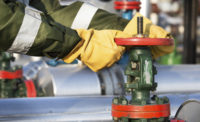A consultant hired by Broomfield, CO to assess risks at planned Extraction Oil & Gas, Inc. well sites within the city identified 36 gaps in safety plans, most of which have since been addressed by city and company best practice guidelines.
However, the consultant, Norwegian-based DNV-GL, did find that two of its recommendations are still not covered by the documents intended to ensure the health and safety of residents.
In presenting findings to city council, DNV-GL senior consultant Marisa Pierce said the hazard identification team, which was made up of representatives from city government, North Metro Fire Rescue District, Extraction and DNV-GL, identified 412 hazard scenarios.
A hazard scenario was defined as having the "potential to result in impacts to people, the environment, property or credibility."
Of those scenarios identified none were considered high risk, five serious risk, 71 medium risk and 336 low risk.
Low risk is defined as when a hazard or impact has been adequately addressed; medium is when a risk management action should be taken within a defined time period; serious means hazards should be corrected as soon as possible and interim controls should be put in place; and high is when a hazard should be reduced by interim or final controls before being allowed to proceed, according to the company.
"Each scenario was assessed independently, not as an accumulative risk," Pierce said, which is typical by industry standards when conducting a qualitative risk assessment.
She said all five serious risk scenarios were related to increased traffic expected in all phases of development resulting from the number of trucks carrying dirt, water, fracking fluids and equipment on nearby roads.
Yellico said the hazard identification team spent a lot of time looking at traffic and outlining training, certifications and licensing safeguards.
"There's also the safety culture (that) Extraction has to enforce, "she said.
At the end of its independent review, DNV-GL brought 36 recommendations to Broomfield and Extraction for further discussion and adding safeguards and mitigating factors. Of those, 34 were addressed, leaving only two outstanding.
The two outstanding recommendations proposed by DNV-GL, which address medium-risk scenarios, are asking Extraction to add a response to ignited oil droplets to its emergency response plans, and to consider creating "bowties" compliant with Center for Chemical Process Safety guidelines. Bowties are diagrams that illustrate barriers to prevent hazard scenarios, as well as whose responsibility it is to address such scenarios and their consequences.
Pierce said Extraction was addressing oil droplets, but not calling them out as a hazard.
The contract with DNV-GL, which was signed in October, included producing a third-party risk assessment associated with new oil and gas development and identifying mitigation measures that should be added to Broomfield's regulations.
Tami Yellico, director of strategic initiatives, said the assessment, which cost about $75,650, is intended to be a living document that can be changed as new technology is introduced or an unforeseen incident occurs.
Broomfield's primary focus in commissioning the assessment was public health, safety and welfare, she said. A secondary purpose was for policy purposes.
Yellico believes the state should take a look at causes of oil and gas-related safety incidents around Colorado, complete its own assessment and use those findings to adopt regulations.
Source: Broomfield Enterprise



